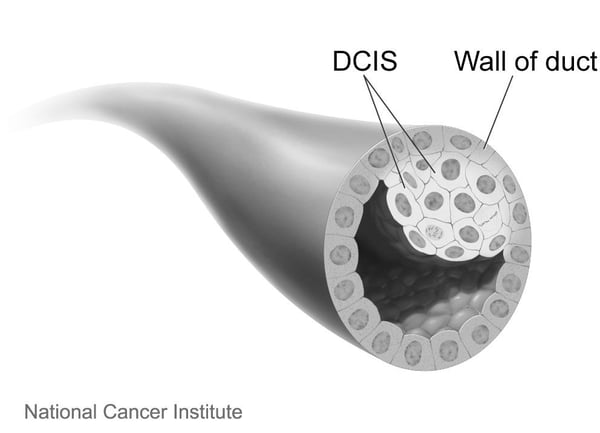Getting called back after your mammogram for follow-up can be stressful and worrying—even more so if you’re not sure what the results of your follow-up tests may mean for your health. Ductal carcinoma in situ (DCIS) is the most commonly diagnosed form of non-invasive breast cancer, accounting for about 1 in 5 breast cancer cases. Each year, approximately 60,000 patients in the U.S. are diagnosed with DCIS.[1] Learn what you should know if you or someone you love is touched by this condition.
What are the signs of DCIS?
Ductal carcinoma in situ rarely presents symptoms, although some patients notice a lump or unusual nipple discharge prior to diagnosis. Approximately 80% of cases are found via mammography,[2] suggesting that regular screening is a vital line of defense.
Is DCIS cancer?
Although DCIS is considered breast cancer, it is not life threatening in itself because it is contained within the milk ducts and has not infiltrated any of the surrounding tissue. DCIS does, however, increase the odds that invasive cancer will develop in the future; because doctors are not able to determine which cases will progress to infiltrating cancer, treatment is generally advised.[3]

What treatment is recommended for DCIS?
Most often, lumpectomy followed by radiation is recommended for treatment of DCIS. However, individual recommendations can vary depending on the tumor’s size, likelihood to recur after surgery (expressed as tumor grade), and hormone receptor status. In some cases, mastectomy is recommended, while in others, lumpectomy without radiation is deemed sufficient. If the tumor is hormone-receptor positive, then drugs to lower hormone levels may also be prescribed.[4] If you have questions about the characteristics of your tumor or the course of treatment recommended for you, ask your doctor. You have the right to a clear explanation of your treatment options and why one is recommended over another.
What is the prognosis for patients with DCIS?
Research suggests that without treatment, 40–50% of DCIS patients will develop invasive cancer.[5] With treatment, however, DCIS survival is close to 100%.[6]
Iowa Radiology provides complete breast imaging services, including low-dose 3-D mammography, breast MRI and ultrasound, and imaging-guided biopsy. For more information about breast imaging or breast cancer, feel free to browse our complimentary resources by clicking the links below.
[1] "DCIS — Ductal Carcinoma In Situ." Breastcancer.org, 16 Aug 2018. Accessed 30 Aug 2018.
[2] "Signs and Symptoms of DCIS." Breastcancer.org, 18 Feb 2016. Accessed 29 Nov 2017.
[3] "Treatment for DCIS." Komen.org. Susan G Komen, 11 March 2017. Accessed 29 Nov 2017.
[4] “Treatment for DCIS.” Breastcancer.org, 22 Feb 2017. Accessed 30 Aug 2018.
[5] "Treatment for DCIS." Komen.org. Susan G Komen, 11 March 2017. Accessed 29 Nov 2017.
[6] "Prognostic factors and Survival Rates for Ductal Carcinoma in Situ (DCIS)." Moose & Doc Breast Cancer. Steven Halls, 29 Aug 2018. Accessed 30 Aug 2018.
The information contained in the Iowa Radiology website is presented as public service information only. It is not intended to be nor is it a substitute for professional medical advice.You should always seek the advice of your physician or other qualified healthcare provider if you think you may have a medical problem before starting any new treatment, or if you have any questions regarding your medical condition.
Iowa Radiology occasionally supplies links to other web sites as a service to its readers and is not in any way responsible for information provided by other organizations.


